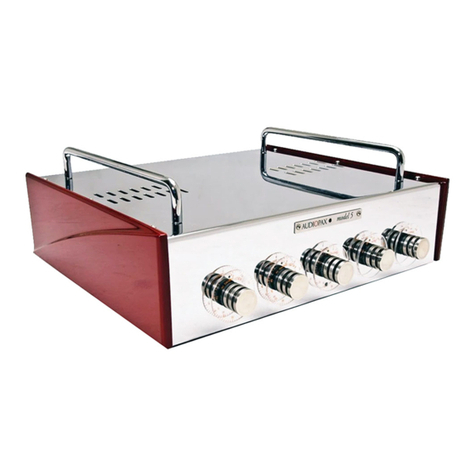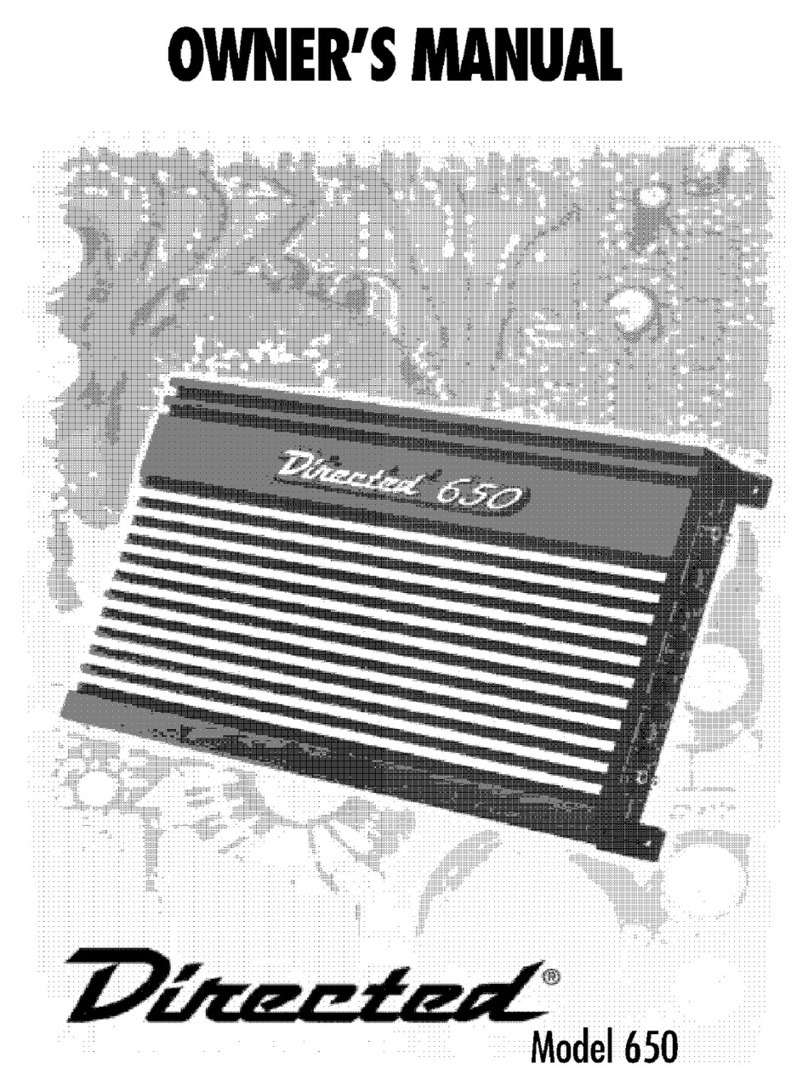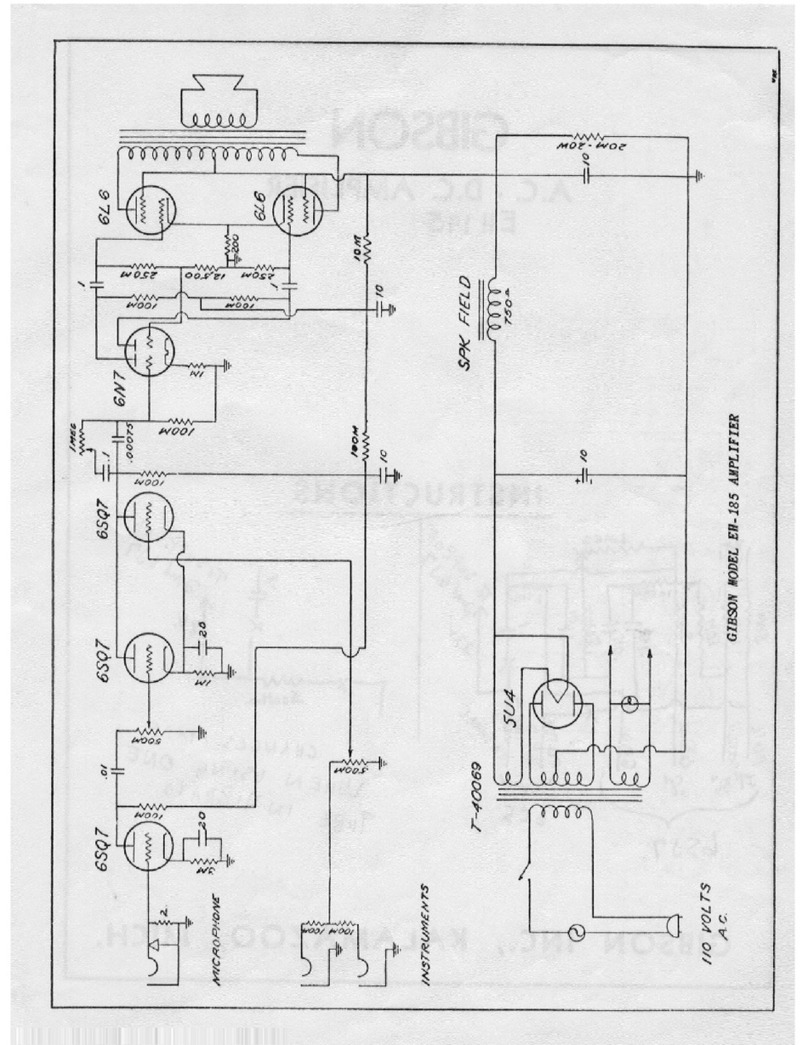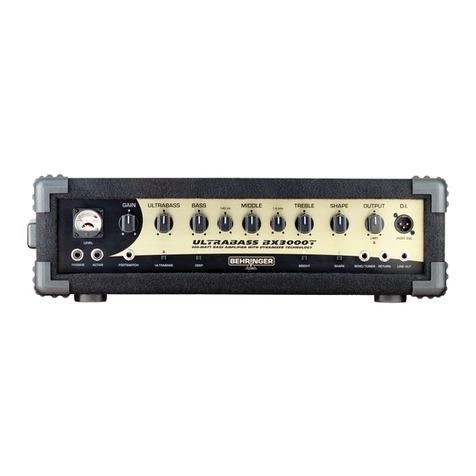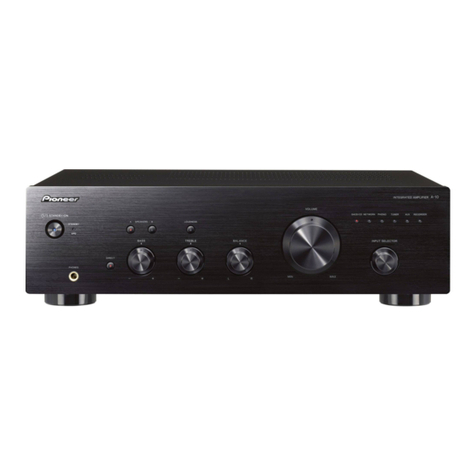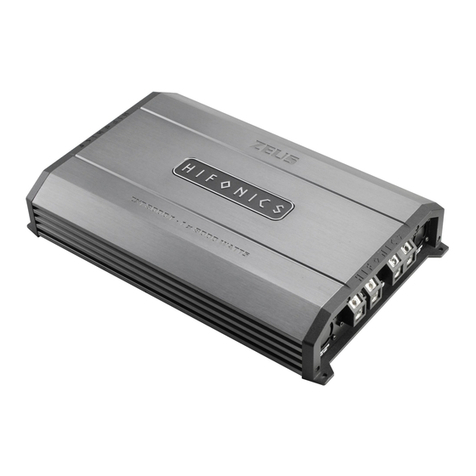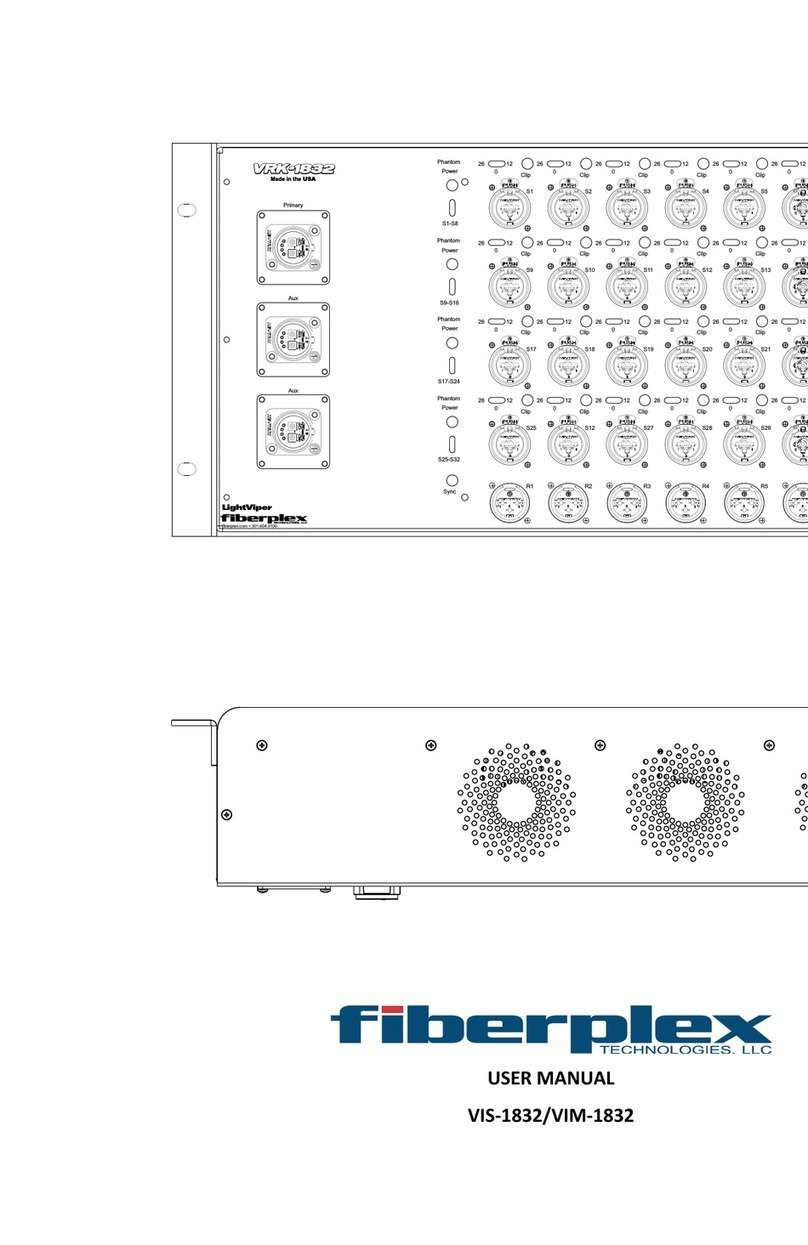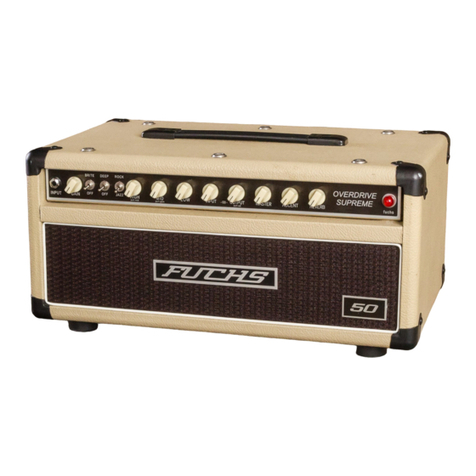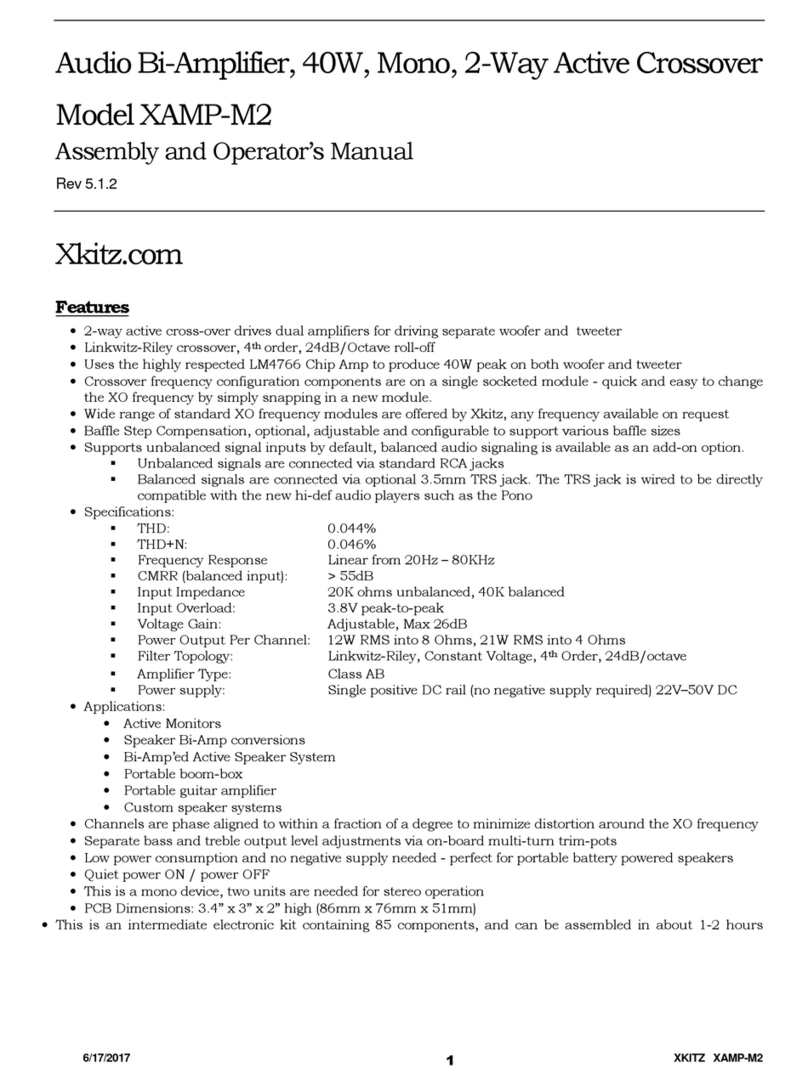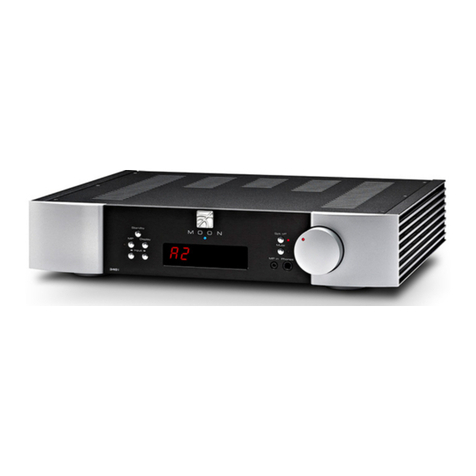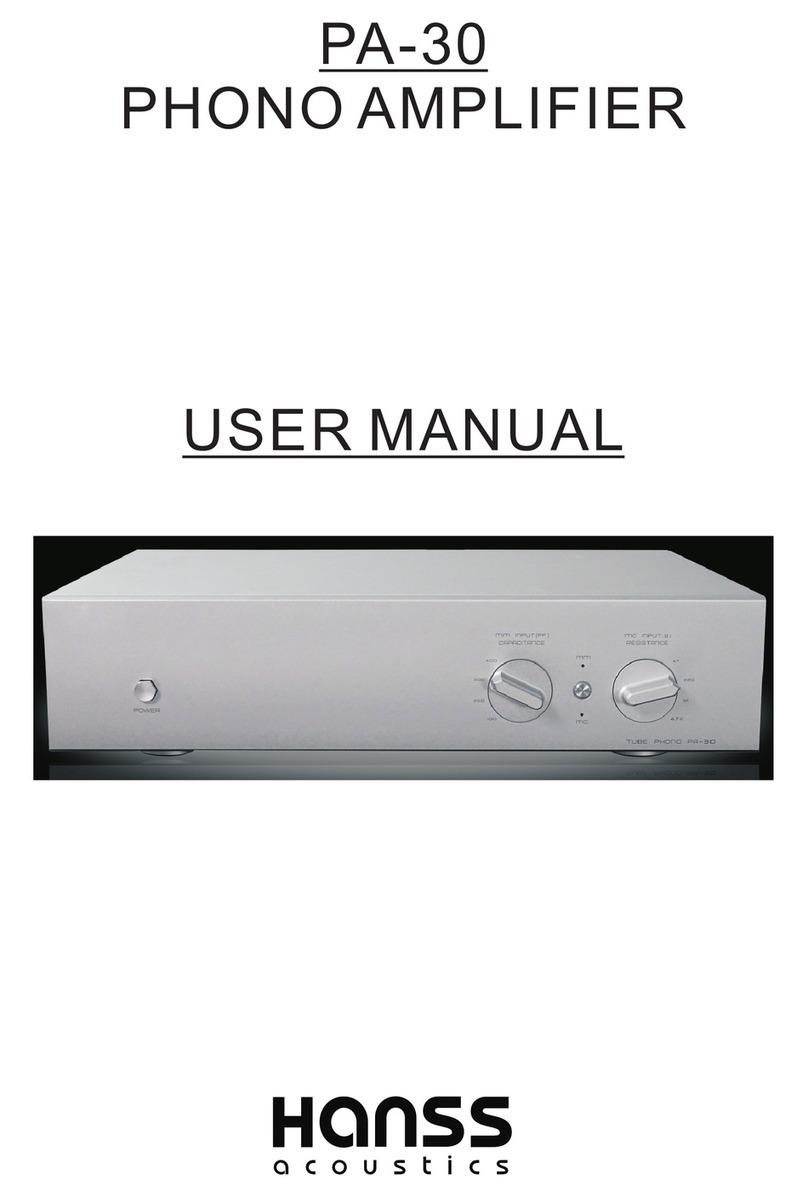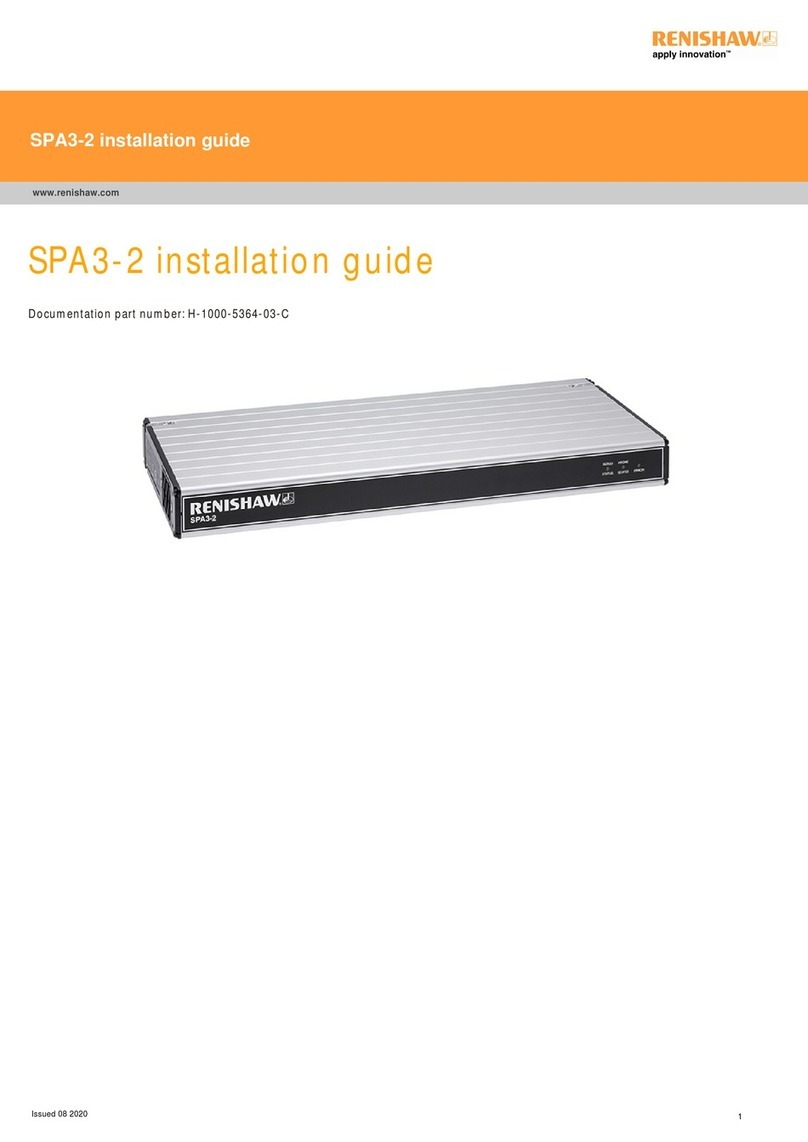Audiopax 88 User manual

MODEL 88

1
Index
Introduction 2
Installation 4
Turning on your Model M88 5
The Timbre Lock®6
Model M88 as an inverter amplifier 9
Specifications 10
Support 11

2
Introduction
Thank you for choosing Audiopax Model M88, our acclaimed 30W per channel single-
ended (class a1) amplifier that has been described as “a legend in its own time”. It is not only a
beautifully crafted piece of art using the best possible audio components - but also one of the
most innovative pieces of equipment on the market, with several unique features and topology
so revolutionary among tube amplifiers that it is probably the only major innovation in this
category in recent decades. It is a piece of recognized equipment worldwide, with numerous
international awards and enthusiastic reviews, being a reference for amplifiers worldwide.
Each component used in your Model 88 was carefully selected for maximum
performance and the synergy among the components is taken into account - a perfect balance
between specific qualities and their overall effect is a key point to achieve its unique sound. This
includes not only the choice of the electronic parts (resistors, capacitors, inductors, wiring,
sockets, connectors, etc.) but also several innovations in the fields of electromagnetic
interference canceling and vibration control. As a good example, Audiopax is one of the few
companies in the audio market that uses coupling capacitors developed specifically for their
equipment, in a successful association with the Jupiter Condenser, one of the main brands
specialized in it. Model 88 is also one of the rare pieces of equipment that uses brass as the
main material for its chassis (a material that is much more expensive than aluminum or steel),
something that due to its diamagnetic characteristics, has the capacity to generate inverted
magnetic fields at its interior that can cancel external ones.
Besides all the care and craftmanship used in its components, Model 88 has several
exclusive technologies, as described below.
Timbre Lock®
Simply placed, it is an “adjustment to the smallest perceived distortion of the system as a
whole”. At its inception, for the first time the design of an amplifier “sacrificed” equipment
measurements to prioritize the listener's real perception by taking advantage of the predictability
of distortion patterns, achieving the highest possible rate of cancellation between distortions
generated by an amplifier with those generated by the speakers. Timbre Lock®won the top
award from Hi-Fi News, England's most traditional audiophile magazine, the Industry Award
2003 for Best Valve Amplifier Innovation, and was described by it as "a great application that
works; simply and simply. ”

3
IDS ("Ideal Device Simulator")
The idea of the IDS came about from the desire to get the same "magic" of 300B with
other devices. This was made possible by the creation of a new topology (named LM3 - Low Mu
Triode with Higher Raw Efficiency Emulator), where the interaction between different tubes and
the output transformers allowed the perfect emulation of the known qualities of that unique tube.
With the success of this implementation an even more challenging idea arose: if it is possible to
emulate a specific tube why not to emulate an "ideal" one - a device that didn't exist but that
would add all the magic of the 300B, the dynamics of the 845/211, the transparency of 2A3, the
perfect tone of 45 and (why not?) the best features of solid-state devices. This challenge was
achieved successfully with the IDS, which makes Model 88 the only single-ended tube amp that
utilizes a dream tube never produced before - an "Ideal Audio Triode", whose behavior has
been carefully designed by Audiopax itself. It is, therefore, one of the only amplifiers on the
market that simultaneously adds the best characteristics of the tube amplifiers (musicality, no
distortion in odd harmonics, a "magic" and "warm" middle region, dynamic distortion spectrum
for power and frequency similar to that of a mid-range speaker - allowing for greater statistical
cancellations, etc.) to the best solid-state characteristics (long and fast transient and frequency
response, sweeping dynamics, very low noise, etc.).
ASTAT ("Asymmetrical Series Twin Amplifier
Topology")
It is the carefully controlled combination of slightly different output transformers
connected in series and powered by independent and entirely unpowered sources, meaning
that each Model 88 monoblock is actually composed of two complete, independent and
asymmetrical amplifiers. The concept is unique in the audio market and allows for maximum
flexibility in circuit design, creating a radically innovative form of music reproduction.
Furthermore, it is a concept that has been successfully used in many other fields: the stability of
a helicopter, for example, is achieved by devices that generate asymmetric forces. The ASTAT
concept makes Model 88 one of the rare single-ended class a1 tube amplifiers to reach its
power range reliably and stably.

4
Installation
Your Model 88 is shipped in two boxes containing:
●Two monoblocks (one for each channel)
●Two tube quartets (each with two input and two power tubes)
●Extra fuses
Your manual is available for download from our website: www.audiopax.com.
The monoblocks should be installed in an airy area, avoiding enclosed spaces (such as
cabinets) and maintaining an empty surface of at least 30 cm above them. As your on/off switch
is located at the rear of the equipment, it is also important that this space is easily accessible. It
achieves optimal operating conditions within 30 minutes and should be turned off whenever long
periods until the next listening session may occur (this recommendation is made to extend the
life of your tubes). For the best sound, we advise you to also install it in a location free of excess
bass, avoiding interference and feedback in your tubes (as room corners).
With the monoblock already in its final position, it is now necessary to install the tubes,
which will only fit in its correct position. For the 12AT7 (input tubes), you just have to match the
biggest distance between their pins with the same space at the sockets. For the KT88s (power
tubes), you just have to match the guide plastic pin below it with the hole at the sockets. Once
the correct position is reached, gently press each tube until its base fully touches the socket and
they are 100% perpendicular to the chassis.
Without connecting the AC cable, make sure that the “Power On/Off” switch on the rear
of each one of the amplifiers is in their “Off” position. Connect the signal input RCA cables
(black/white: left channel; red: right channel), the speaker cables to the appropriate binding
posts (taking care to put both with the same polarities). Finally connect the power cord to the
IEC connector, respecting the nominal voltage of your Model 88 (120V or 230V).

5
Turning on your Model 88
On its top panel, Model 88 has two potentiometers surrounded by LED rings and
two toggle switches over them. These potentiometers are the Timbre Lock®
adjustments, one of the truly unique features of Audiopax products. Before turning on
the equipment for the first time, set all adjustments (two on each monoblock) to their
minimum position, ie fully counterclockwise.
Locate the Power switch on the back of the amplifier and turn it on (up position)
without any music playing, that is, with no sound at all. To protect the tubes by ensuring
their filaments are properly preheated, Model 88 uses an internal timer that only
releases its operation after approximately 30 seconds (you may then hear a small click
from an internal relay). When this occurs, wait another minute and turn the switches
over the Timbre Lock®potentiometers, slowly adjusting them clockwise until the yellow
led corresponding to each control is reached. Then, the switch must be switched back
to the “Off” position. After this initial set, you can finally start to listen to music.

6
The Timbre Lock®
The Timbre Lock®is an Audiopax invention that allows the best possible match
of the distortion behavior of their amplifiers with any of their speakers, resulting in the
best distortion spectrum for the system as a whole (we can consider it as an
“adjustment to the lowest system distortion”). At its inception, for the first time the design
of an amplifier “sacrifices” the traditional concepts of measurements to prioritize the
listener's real perception. From the standpoint of distortion, which is usually the weakest
parameter in a speaker, it is also a setting that lets it achieve the maximum of its
performance. Timbre Lock® won the top award from Hi-Fi News, England's most
traditional audiophile magazine, the Industry Award 2003 for Best Valve Amplifier
Innovation, where it was described as a “genius application that works; quite simply”.
Timbre Lock®sound effects do not operate in the frequency domain, like
conventional tone controls, but rather optimize the residual harmonic distortion
spectrum between the amplifier and the speakers. This unique adaptability allows you to
control this critical interface of an audio system and thereby adjust instrumental tones,
micro-dynamics, general definition, bass impact and articulation, even the emotional
involvement factors and musicians 'presence' in your listening room.
Each system is different, as well as each listener has different musical values,
sensibilities, and preferences and all of these variables define the best Timbre Lock®
adjustment for you. The fact is that, when you get it right, things clearly stay in place.
Your musical appreciation and involvement will intensify and reach a higher level. But
as it is simply impossible to predict what your ideal configuration will be, we can only
give you a rough idea of how to adjust it, as you will see below.
An important note: The Timbre Lock®adjustment should always be done without
the amplifier playing music, that is, it must be without signal at its input.

7
The left control of the Timbre Lock®at each one of the Model 88 monoblocks
usually gives you the impression of changes at the bass articulation and attack,
especially with high-efficiency loudspeakers. Turning its potentiometer counterclockwise
(first or second LED) makes the overall sound drier while turning it clockwise can
appear to reduce impact, attack, and internal detail after the fifth LED. Between these
two positions, you will soon realize the effects on the overall presentation until getting
the best position for the right amount of warmth, presence, and resolution. You could
thus think of the left control as a "definition control". So, generally speaking, in a correct
Timbre Lock® setting, this will ends with one of the first five of the LEDs turned on.
The right control of the Timbre Lock®at each one of the Model 88 monoblocks
usually gives you the impression that it affects the overall smoothness and tone. Again,
going counterclockwise the sound turns progressively lighter and drier and clockwise it
becomes softer and warmer. Moving this position away from the ideal setting in the
clockwise direction will make the sound fuzzier and less rich, in the same way, moving it
away from the ideal setting in the counterclockwise direction it will make it bodyless,
empty. Think of this control as "sound density".
Besides the left/right potentiometers adjustments, that gives you a kind of a dial
to get the best balance between warmer (but softer), when you go to clockwise
direction, and clearer (but drier), when you go counterclockwise, you can also get new
nuances changing the offset between the two adjustments, that is, depending the
amount of LEDs positions you have between the left and right adjustments in a single
monoblock. This affects different qualities simultaneously, the perceived final extent of
the high frequencies against the mid-range attack, the mid-range brightness rather than
too much internal detail and transparency, emotion rather than extreme resolution.
Usually, the ideal range of this difference goes from 1 to 3 LEDs (bigger values may
interfere with the overall perception of the sound image) and selecting the appropriate
difference for your system is often more important than the absolute position of each
one of the controls.
In Model 88 the yellow LEDs define the preferred starting position for the
adjustments. As it also has enough adjustment range to work with any brand of tubes
and even to get more from aged tubes (you certainly will always get the most of it with
these amplifiers), Model 88 has red LEDs that are a clear indication that you are
approaching dangerous presets regarding your tube's life. So, they should never be
used as a preset position.
We recommend that when you first turn on the amplifier, you adjust the Timbre
Lock® after a few minutes and again after about 20 minutes of power on. You should
first try to familiarize yourself with the effects of Timbre Lock®and then look for the

8
most pleasant configuration for your system and yourself. It is there to optimize the
musical engagement factor of your system - a truly new concept that is much more
refined and therefore ultimately more powerful than tone controls. With careful setting,
Timbre Lock® can deliver a unique experience and connect you closely with the thrill of
your favorite musicians' performance.
Please be aware that any "not ideal position" for the Timbre Lock®is, in reality,
the "normal" situation for almost every system, out of some very rare combinations that
are usually described as "these amps and speakers have a wonderful synergy". With
the Model 88, this "synergy" is always in your hands - think about that!

9
Model 88 as an inverter amplifier
Model 88 is a phase inversion amplifier and, depending on the other components of
your system, perhaps the best sound result will occur with the normal phase. In this case,
reverse the phase in any component containing this feature or at the speakers' cables, inverting
on both channels the polarity of one of the ends (amplifiers or speakers) to achieve the best
possible performance.

10
Specifications
Maximum power: 30Watts RMS per channel at 1kHz, 4 or 8 ohms
Frequency Response: 14Hz to 100kHz (-3dB)
Signal to Noise Ratio: Better than 90dB, (A-weighted) ref. 30W
Gain: 18dB
Input Impedance: 220K Ω
Output Impedance: 3.7 Ω
Absolute signal polarity: Inverted
Input Voltage: 120V or 230V (+- 5%)
Max. Power Consumption: 110W
Fuses: 4A (120V) or 2.5A (230V), slow, 6.3mm (main)
250mA to 500mA, fast, 6.3mm (output tubes)
Monoblock dimensions: 20cm (W) x 38cm (D) x 31cm (H)
Net Weight: 18 Kg
Finishes: Chassis: Chrome
Sides/Bases: Black Piano or Bordeaux
Optional: Transformer balanced input

11
Support
Model 88's circuits and transformers are designed to deliver the best possible sound
performance with extremely conservative bias, temperature, and overall operating parameters
for its tubes and parts, resulting in a piece of extremely reliable equipment with a very long tube
life. However, if you have any problems, check the list below initially - possibly it can be solved
using this simple checklist.
●Problem: The amplifier does not turn on
○Possible solutions
■With the equipment turned off check
●The AC cable connection
●The main fuse
●Problem: No sound
○Possible solutions
■Check the interconnect and loudspeaker cables connection
■Check sound source (especially selection, volume and mute control at the
preamplifier)
■With the equipment turned off, check the main fuse
●Problem: Distorted sound
○Possible solutions
■Reverse the interconnect and speaker cables between channels to verify
if the problem is from the source or from the loudspeakers
■With the equipment turned off, check the tube fuses (please avoid
touching the metal parts of it, that can be charged even after the power
off of the amplifier)
■Verify all Timbre Lock®controls operations and check the tube fuses in
case of any problems.
■Try to exchange the tubes between the two internal amplifiers of each
monoblock (initially, try to exchange all of it and then each one separately
- input or power)
●Problem: Abnormal fluctuation of Timbre Lock®LEDs
○Possible solutions
■Swap the tubes between channels to check if the problem is in one of
them
■Check if you are having any AC fluctuation at this moment (something
that can affect the Timbre Lock®measurement
Table of contents
Other Audiopax Amplifier manuals
